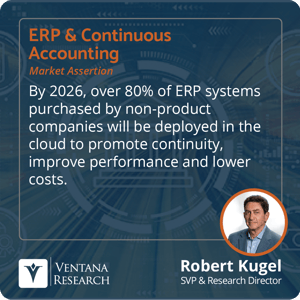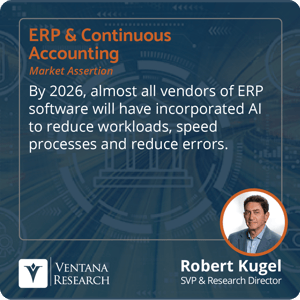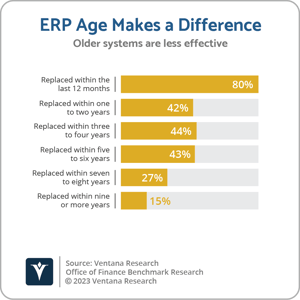The cloud has come to dominate many business software categories, but until recently, enterprise resource planning for manufacturing and product-focused organizations has been a notable laggard. Cloud-based systems can be less costly to operate, perform better, be more secure and shift maintenance and update chores from the IT department to the vendor, freeing IT teams to concentrate on more strategic needs.
However, for some types of businesses, adoption of cloud-based systems was initially held back by functionality or process design limitations as well as concerns about reliability and security. These issues have been steadily diminishing as ongoing development of cloud offerings and technology make them suitable for the specific needs of a broader set of buyers.
Cloud vendors have demonstrated reliability and even superior security compared to what most organizations can achieve with on-premises software. Moreover, vendors that employ a platform strategy can use the cloud to  offer more flexible and easier-to-manage architecture than on-premises systems. A cloud-based platform facilitates the creation of a digital ecosystem that enables a software buyer to enhance customer experiences. For these reasons, Ventana Research asserts that by 2026, more than one-half of manufacturing organizations will use a cloud-based core ERP system to promote continuity, improve performance and lower costs.
offer more flexible and easier-to-manage architecture than on-premises systems. A cloud-based platform facilitates the creation of a digital ecosystem that enables a software buyer to enhance customer experiences. For these reasons, Ventana Research asserts that by 2026, more than one-half of manufacturing organizations will use a cloud-based core ERP system to promote continuity, improve performance and lower costs.
Manufacturers and other organizations such as distributors that deal in products are increasingly moving core ERP systems to the cloud. Roadblocks to cloud adoption have been reduced as vendors deliver more verticalized offerings and opportunities to customize multi-tenant software.
Initially, multi-tenant cloud-based subscription ERP systems – those where software customers share computing resources while keeping data separate and secure – provided limited scope to adapt systems to specific requirements and preferences in terms of configuration and customization. Ventana Research uses the term “configuration” to refer to a system’s native tools that are used to change its behavior or features without changing the underlying code. This enables subscription software providers to update core code without affecting configurations made by customers. We use the term “customization” to refer to a feature, extension or modification that involves custom coding or some form of special implementation but likewise does not affect the code shared by all customers.
Cloud ERP vendors allow customers to configure specific instances from a set of options (such as user interface layout or process definitions). Initially, many organizations found these options less robust than desired, and could not customize the underlying code to suit specific operations, practices and preferences, which is a common expectation with on-premises systems. This issue caused many product-based organizations to delay cloud adoption, since configuration options were too limited for industry-specific processes. Especially in manufacturing, an organization’s idiosyncratic process designs are regarded as an important differentiator, regardless of whether that assessment is justified or not.
On-premises vendors have long offered systems designed for specific industries (verticals) and even segments of an industry (subverticals) to reduce the total cost of ownership and accelerate time to value. Details matter when it comes to ERP systems. Especially within a broad industry category like automotive or food and beverage, there are significant subverticals with unique requirements. For instance, companies that make or distribute vehicle parts, either sold to original equipment manufacturers or in the aftermarket, have distinct needs, as do automotive service and repair entities. Systems designed for brewers have requirements distinct from organizations selling dairy or carbonated beverages. ERP vendors have applied this strategy to the cloud as well, reducing the time and cost associated with configuring a system for the specific requirements of the buyer, and over time addressing gaps in capabilities for those buyers with specific requirements. Vertical ERP solutions also support specific business processes, types of information and metrics peculiar to a certain type of business, and serve the specific needs of those with job responsibilities associated with an industry.
Beyond verticalization, ERP vendors have also enabled users greater freedom in customizing how the system operates without having to modify the multi-tenant software. Technology has made it possible for organizations to customize a multi-tenant application to perform processes in a way that conforms to specific requirements without affecting the vendor’s code. This greatly expands the adaptability of a multi-tenant system to suit the needs of individual organizations. Subscription-based software may be customized by extensions connected to the core system using application programming interfaces provided by the vendor. Both developments have reduced barriers to adopting cloud applications, meaning that a higher portion of manufacturing and product-focused companies are able to take advantage of cloud benefits.
Further benefits will accrue as vendors incorporate artificial intelligence to reduce workloads, speed completion of tasks, reduce training and improve individual and business unit performance. Cloud-based systems facilitate machine learning because they can apply the elastic resources at lower cost and draw on broader datasets. The useful and successful application of artificial intelligence will be an increasingly important source of differentiation, particularly in managing inventories, supply chains, logistics and administration – especially in process management. Ventana Research asserts that by 2026, almost all vendors of ERP software will incorporate AI to reduce workloads, speed processes and reduce errors. Vendors will be challenged because the bar will be constantly rising and require rapid innovation, especially in enabling systems to streamline processes, automating tasks that are repetitive while simplifying choices for individuals where situations are ambiguous or where there is no substitute for judgment and experience. Product-oriented businesses can also benefit from incorporating complementary technologies such as augmented reality for warehouse operations or sales.
facilitate machine learning because they can apply the elastic resources at lower cost and draw on broader datasets. The useful and successful application of artificial intelligence will be an increasingly important source of differentiation, particularly in managing inventories, supply chains, logistics and administration – especially in process management. Ventana Research asserts that by 2026, almost all vendors of ERP software will incorporate AI to reduce workloads, speed processes and reduce errors. Vendors will be challenged because the bar will be constantly rising and require rapid innovation, especially in enabling systems to streamline processes, automating tasks that are repetitive while simplifying choices for individuals where situations are ambiguous or where there is no substitute for judgment and experience. Product-oriented businesses can also benefit from incorporating complementary technologies such as augmented reality for warehouse operations or sales.
ERP vendors are also adopting a vertical-plus strategy. The plus means it’s a platform, not just an application. A successful platform strategy enables a vendor to easily work with third parties to rapidly create products and services that are complementary to its core technology, adding value to both parties’ offerings. A platform in this sense can also be used to facilitate interactions between a vendor’s customers, enabling trusted transactions and creating value through a network effect. A platform approach to architecture will be particularly important for ERP vendors addressing product-focused verticals because of the increasing availability of sensors and devices that substantially boost productivity, enhance quality or improve user experience. For example, while the attraction of the metaverse as a consumer product is still uncertain, augmented reality devices and their use in spatial computing will be highly valuable in organizations that make, move or sell physical goods.
Because of its centrality in managing operational and financial processes of a business, replacing an ERP system is an infrequent event: Our Next Generation ERP Benchmark Research found that the average  age of a system is seven years, which suggests that, on average, they are replaced after 14 years. The research also shows that satisfaction with ERP system performance degrades over time. Fewer than one-fourth of organizations with an ERP system that is seven years or older say the system performs very well. A reluctance to switch is understandable, since it involves considerable cost. There is often disruption to operations as workers become familiar with the new system, and there is risk that the implementation will not be done well or that the organization chose the wrong vendor. Still, there are costs and risks when organizations fail to replace aging systems on a timely basis. A recent example was Southwest Airlines, which was plunged into chaos during bad weather because it failed to invest in operational systems.
age of a system is seven years, which suggests that, on average, they are replaced after 14 years. The research also shows that satisfaction with ERP system performance degrades over time. Fewer than one-fourth of organizations with an ERP system that is seven years or older say the system performs very well. A reluctance to switch is understandable, since it involves considerable cost. There is often disruption to operations as workers become familiar with the new system, and there is risk that the implementation will not be done well or that the organization chose the wrong vendor. Still, there are costs and risks when organizations fail to replace aging systems on a timely basis. A recent example was Southwest Airlines, which was plunged into chaos during bad weather because it failed to invest in operational systems.
The ERP market is both mature and highly competitive, and buyers have a wealth of choices for deploying on premises or in the cloud, or to select a vendor that explicitly supports the type of business or offers a more general application. I recommend that rapidly growing companies, businesses with systems that were initially deployed more than seven years ago and organizations using on-premises ERP systems assess whether a new system can improve performance, streamline operations and future-proof operations.
Regards,
Robert Kugel

 offer more flexible and easier-to-manage architecture than on-premises systems. A cloud-based platform facilitates the creation of a digital ecosystem that enables a software buyer to enhance customer experiences. For these reasons, Ventana Research asserts that by 2026, more than one-half of manufacturing organizations will use a cloud-based core ERP system to promote continuity, improve performance and lower costs.
offer more flexible and easier-to-manage architecture than on-premises systems. A cloud-based platform facilitates the creation of a digital ecosystem that enables a software buyer to enhance customer experiences. For these reasons, Ventana Research asserts that by 2026, more than one-half of manufacturing organizations will use a cloud-based core ERP system to promote continuity, improve performance and lower costs. facilitate machine learning because they can apply the elastic resources at lower cost and draw on broader datasets. The useful and successful application of artificial intelligence will be an increasingly important source of differentiation, particularly in managing inventories, supply chains, logistics and administration – especially in process management. Ventana Research asserts that by 2026, almost all vendors of ERP software will incorporate AI to reduce workloads, speed processes and reduce errors. Vendors will be challenged because the bar will be constantly rising and require rapid innovation, especially in enabling systems to streamline processes, automating tasks that are repetitive while simplifying choices for individuals where situations are ambiguous or where there is no substitute for judgment and experience. Product-oriented businesses can also benefit from incorporating complementary technologies such as augmented reality for warehouse operations or sales.
facilitate machine learning because they can apply the elastic resources at lower cost and draw on broader datasets. The useful and successful application of artificial intelligence will be an increasingly important source of differentiation, particularly in managing inventories, supply chains, logistics and administration – especially in process management. Ventana Research asserts that by 2026, almost all vendors of ERP software will incorporate AI to reduce workloads, speed processes and reduce errors. Vendors will be challenged because the bar will be constantly rising and require rapid innovation, especially in enabling systems to streamline processes, automating tasks that are repetitive while simplifying choices for individuals where situations are ambiguous or where there is no substitute for judgment and experience. Product-oriented businesses can also benefit from incorporating complementary technologies such as augmented reality for warehouse operations or sales. age of a system is seven years, which suggests that, on average, they are replaced after 14 years. The research also shows that satisfaction with ERP system performance degrades over time. Fewer than one-fourth of organizations with an ERP system that is seven years or older say the system performs very well. A reluctance to switch is understandable, since it involves considerable cost. There is often disruption to operations as workers become familiar with the new system, and there is risk that the implementation will not be done well or that the organization chose the wrong vendor. Still, there are costs and risks when organizations fail to replace aging systems on a timely basis. A recent example was Southwest Airlines, which was plunged into chaos during bad weather because it failed to invest in operational systems.
age of a system is seven years, which suggests that, on average, they are replaced after 14 years. The research also shows that satisfaction with ERP system performance degrades over time. Fewer than one-fourth of organizations with an ERP system that is seven years or older say the system performs very well. A reluctance to switch is understandable, since it involves considerable cost. There is often disruption to operations as workers become familiar with the new system, and there is risk that the implementation will not be done well or that the organization chose the wrong vendor. Still, there are costs and risks when organizations fail to replace aging systems on a timely basis. A recent example was Southwest Airlines, which was plunged into chaos during bad weather because it failed to invest in operational systems.








